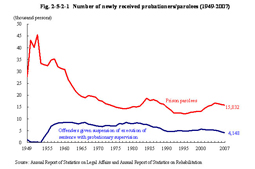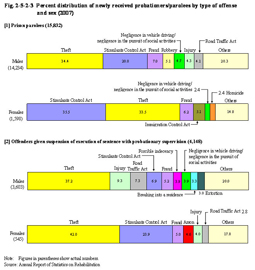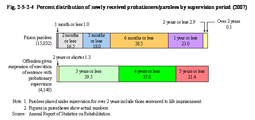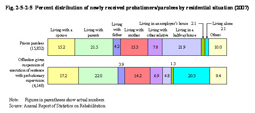| Previous Next Index Image Index Year Selection | |
|
|
1 Probationers / parolees under supervision Fig. 2-5-2-1 shows the trends in the numbers of prison parolees and offenders given suspension of execution of sentence with probationary supervision newly received by probation offices since 1949. The number of newly received prison parolees had been on an upward trend since 1996, but had been decreasing slightly since 2005. The number of offenders given suspension of execution of sentence with probationary supervision has been decreasing since 2001. Fig. 2-5-2-1 Number of newly received probationers/parolees (1949–2007) In regard to the number of offenders under supervision as of December 31, 2007, the number of parolees was 6,701 (down by 8.3% from the previous year), while the number of offenders given suspension of execution of sentence with probationary supervision was 14,107 (down by 4.5% (id.)) (Source: Annual Report of Statistics on Rehabilitation).(2) Characteristics of probationers/parolees a. Age Fig. 2-5-2-2Fig. 2-5-2-2 shows the percent distribution of probationers/parolees newly received in 2007, by age group. Fig. 2-5-2-2 Percent distribution of newly received probationers/parolees by age group (2007) b. Type of offenseFig. 2-5-2-3 shows the percent distribution of probationers/parolees newly received in 2006, by type of offense and sex. The percent ratio was high for theft and Stimulants Control Act violations among prison parolees and female offenders given suspension of execution of sentence with probationary supervision. The percent ratio was high for theft and injury among male offenders given suspension of execution of sentence with probationary supervision. Fig. 2-5-2-3 Percent distribution of newly received probationers/parolees by type of offense and sex (2007) c. Supervision periodFig. 2-5-2-4 shows the distribution rate of newly received probationers/parolees by supervision period in 2007. Supervision periods for most of the offenders given suspension of execution of sentence with probationary supervision were over 2 years, while those for parolees were much shorter and were 6 months or shorter for more than 70% of them. Fig. 2-5-2-4 Percent distribution of newly received probationers/parolees by supervision period (2007) d. Residential situationFig. 2-5-2-5 shows the percent distribution of probationers/parolees newly received in 2007, by residential situation. The percent ratio of those living in halfway houses was highest among prison parolees slightly exceeding those living with parents, while the largest proportion of offenders given suspension of execution of sentence with probationary supervision lived with parents. Fig. 2-5-2-5 Percent distribution of newly received probationers/parolees by residential situation (2007) |




